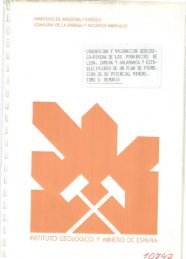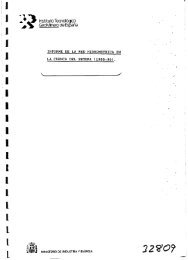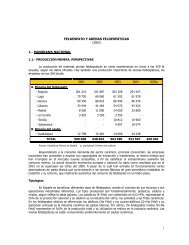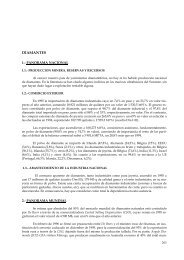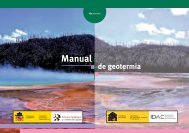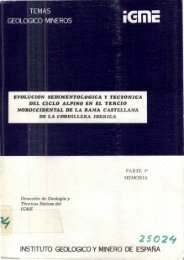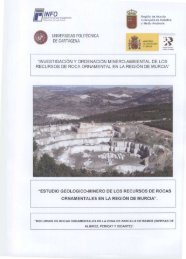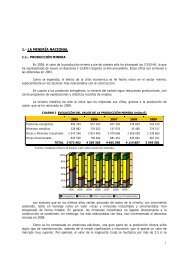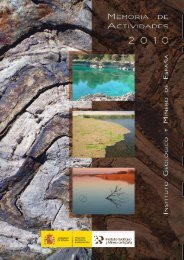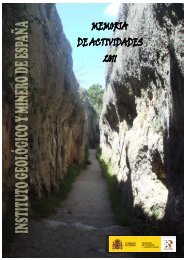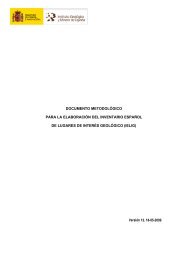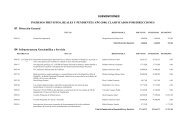mesozoic successions of the betic and iberian ranges - Instituto ...
mesozoic successions of the betic and iberian ranges - Instituto ...
mesozoic successions of the betic and iberian ranges - Instituto ...
Create successful ePaper yourself
Turn your PDF publications into a flip-book with our unique Google optimized e-Paper software.
Permian volcanoclastic <strong>and</strong> lacustrine rocks in <strong>the</strong> centre<br />
<strong>of</strong> <strong>the</strong> Iberian Peninsula (Figure 22).<br />
Most <strong>of</strong> <strong>the</strong> formal Permian <strong>and</strong> Triassic lithostratigraphic<br />
units <strong>of</strong> <strong>the</strong> Iberian Range have been defined<br />
in this area or nearby. Likewise, <strong>the</strong> only magnetostratigraphic<br />
continuous scale for <strong>the</strong> Permian <strong>and</strong><br />
Triassic in <strong>the</strong> Iberian Peninsula has been established<br />
in this section.<br />
Keeping in mind <strong>the</strong> scarcity <strong>of</strong> fossil remains in <strong>the</strong><br />
Permian <strong>and</strong> Triassic continental series <strong>of</strong> Western<br />
Europe, <strong>the</strong>se sections can be considered exceptional<br />
from <strong>the</strong> stratigraphical point <strong>of</strong> view, as <strong>the</strong>y hold<br />
Early Permian <strong>and</strong> Triassic macr<strong>of</strong>lora; Early Permian<br />
(Autunian), Late Permian (Thuringian), Middle Triassic<br />
(Anisian <strong>and</strong> Ladinian), <strong>and</strong> Late Triassic (Carnian)<br />
palynological associations; Early <strong>and</strong> Middle Triassic<br />
vertebrate ichn<strong>of</strong>auna (Figure 23), <strong>and</strong> Middle Triassic<br />
marine fauna, although some <strong>of</strong> <strong>the</strong>m not very abundant<br />
or particularly well preserved.<br />
Also exceptional is <strong>the</strong> sedimentological interest, since<br />
<strong>the</strong> siliciclastic units <strong>of</strong> <strong>the</strong> Lower Triassic <strong>and</strong> part<br />
<strong>of</strong> <strong>the</strong> Middle Triassic are one <strong>of</strong> <strong>the</strong> best <strong>and</strong> globally<br />
known sedimentological models for large, lowsinuosity<br />
(braided) bedload fluvial systems <strong>of</strong> this age.<br />
The geomorphological expression <strong>of</strong> this units is represented<br />
by <strong>the</strong> Hoz del Río Gallo (Gallo River Gorge),<br />
a fluvial morphology upon Upper Permian conglomerates<br />
<strong>and</strong> Lower Triassic red s<strong>and</strong>stones, resulting in<br />
spectacular erosional features (Figure 24).<br />
During <strong>the</strong> Jurassic, <strong>the</strong> Iberian Mountain Range displayed<br />
a system <strong>of</strong> shallow marine shelves over <strong>the</strong><br />
Iberian sub-plate, which was progressively submerged,<br />
representing a part <strong>of</strong> <strong>the</strong> western margin <strong>of</strong> <strong>the</strong> old<br />
Tethys sea. Intracratonic extensional faulting (Álvaro et<br />
al., 1978) determined <strong>the</strong> paleogeographic evolution<br />
<strong>of</strong> <strong>the</strong> shelf <strong>and</strong>, in some regions, <strong>the</strong> synsedimentary<br />
tectonic activity interfered with sea level changes.<br />
Jurassic rocks crop out across a large area in <strong>the</strong><br />
Iberian Mountain Range, <strong>and</strong> are represented by a<br />
thick carbonate rock succession with marl interbeds,<br />
<strong>and</strong> which have been subdivided into a set <strong>of</strong> formal<br />
units. For a better underst<strong>and</strong>ing, <strong>the</strong> terminology is<br />
shown in Figure 25.<br />
Figure 22, above. Lower Permian lacustrine<br />
sediments <strong>of</strong> <strong>the</strong> Capas de la Ermita Fm.<br />
Figure 23, middle. Vertebrate ichn<strong>of</strong>auna<br />
(Chiroterium sp.) within <strong>the</strong> Rillo de Gallo Silt<br />
<strong>and</strong> S<strong>and</strong>stone Formation (Rillo de Gallo).<br />
Figure 24, below. Upper Permian-Triassic Hoz<br />
del Gallo Conglomerate Fm. with<br />
characteristic morphology.<br />
The exceptional exposures <strong>and</strong> <strong>the</strong> abundant <strong>and</strong><br />
valuable fossil record (mostly ammonites) allowed<br />
to establish three sedimentary cycles: Upper Triassic<br />
(Norian)-Middle Jurassic (Aalenian), by Gómez <strong>and</strong><br />
Goy (1997, 2000, 2002, 2005); Middle Jurassic,<br />
by Fernández López (1997), <strong>and</strong> Upper Jurassic, by<br />
Aurell et al. (2000). At <strong>the</strong> same time, several second<br />
order cycles have been identified within <strong>the</strong>se major<br />
order cycles, which, as a consequence <strong>of</strong> <strong>the</strong> definition<br />
<strong>of</strong> a reference scale with biozones, subzones<br />
<strong>and</strong> biohorizons <strong>of</strong> Ammonites, can be correlated<br />
to those identified in Europe. As an example <strong>of</strong> <strong>the</strong><br />
most representative stratigraphic sections worldwide,<br />
<strong>the</strong> sections <strong>of</strong> “La Almunia-Ricla” for <strong>the</strong> Toarcian,<br />
84<br />
Castro, J.M. - García, A. - Gómez, J.J. - Goy, A. - Molina, J.M. - Ruíz Ortíz, P.A. - Sopeña, A.



